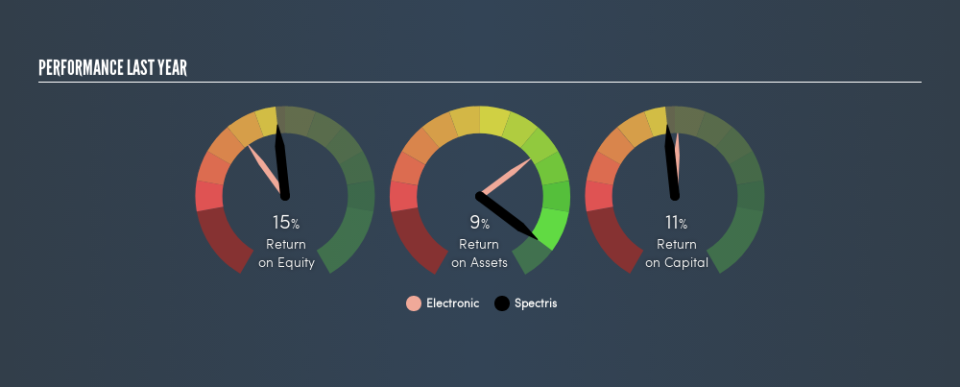Is Spectris plc's (LON:SXS) Capital Allocation Ability Worth Your Time?

Want to participate in a research study? Help shape the future of investing tools and earn a $60 gift card!
Today we'll evaluate Spectris plc (LON:SXS) to determine whether it could have potential as an investment idea. To be precise, we'll consider its Return On Capital Employed (ROCE), as that will inform our view of the quality of the business.
First, we'll go over how we calculate ROCE. Then we'll compare its ROCE to similar companies. Last but not least, we'll look at what impact its current liabilities have on its ROCE.
Return On Capital Employed (ROCE): What is it?
ROCE is a metric for evaluating how much pre-tax income (in percentage terms) a company earns on the capital invested in its business. In general, businesses with a higher ROCE are usually better quality. In brief, it is a useful tool, but it is not without drawbacks. Author Edwin Whiting says to be careful when comparing the ROCE of different businesses, since 'No two businesses are exactly alike.'
So, How Do We Calculate ROCE?
Analysts use this formula to calculate return on capital employed:
Return on Capital Employed = Earnings Before Interest and Tax (EBIT) ÷ (Total Assets - Current Liabilities)
Or for Spectris:
0.11 = UK£188m ÷ (UK£2.1b - UK£424m) (Based on the trailing twelve months to December 2018.)
So, Spectris has an ROCE of 11%.
View our latest analysis for Spectris
Does Spectris Have A Good ROCE?
ROCE can be useful when making comparisons, such as between similar companies. Using our data, Spectris's ROCE appears to be around the 14% average of the Electronic industry. Independently of how Spectris compares to its industry, its ROCE in absolute terms appears decent, and the company may be worthy of closer investigation.
When considering ROCE, bear in mind that it reflects the past and does not necessarily predict the future. Companies in cyclical industries can be difficult to understand using ROCE, as returns typically look high during boom times, and low during busts. This is because ROCE only looks at one year, instead of considering returns across a whole cycle. What happens in the future is pretty important for investors, so we have prepared a free report on analyst forecasts for Spectris.
How Spectris's Current Liabilities Impact Its ROCE
Current liabilities are short term bills and invoices that need to be paid in 12 months or less. Due to the way ROCE is calculated, a high level of current liabilities makes a company look as though it has less capital employed, and thus can (sometimes unfairly) boost the ROCE. To check the impact of this, we calculate if a company has high current liabilities relative to its total assets.
Spectris has total assets of UK£2.1b and current liabilities of UK£424m. As a result, its current liabilities are equal to approximately 20% of its total assets. Current liabilities are minimal, limiting the impact on ROCE.
What We Can Learn From Spectris's ROCE
Overall, Spectris has a decent ROCE and could be worthy of further research. But note: Spectris may not be the best stock to buy. So take a peek at this free list of interesting companies with strong recent earnings growth (and a P/E ratio below 20).
I will like Spectris better if I see some big insider buys. While we wait, check out this free list of growing companies with considerable, recent, insider buying.
We aim to bring you long-term focused research analysis driven by fundamental data. Note that our analysis may not factor in the latest price-sensitive company announcements or qualitative material.
If you spot an error that warrants correction, please contact the editor at editorial-team@simplywallst.com. This article by Simply Wall St is general in nature. It does not constitute a recommendation to buy or sell any stock, and does not take account of your objectives, or your financial situation. Simply Wall St has no position in the stocks mentioned. Thank you for reading.

